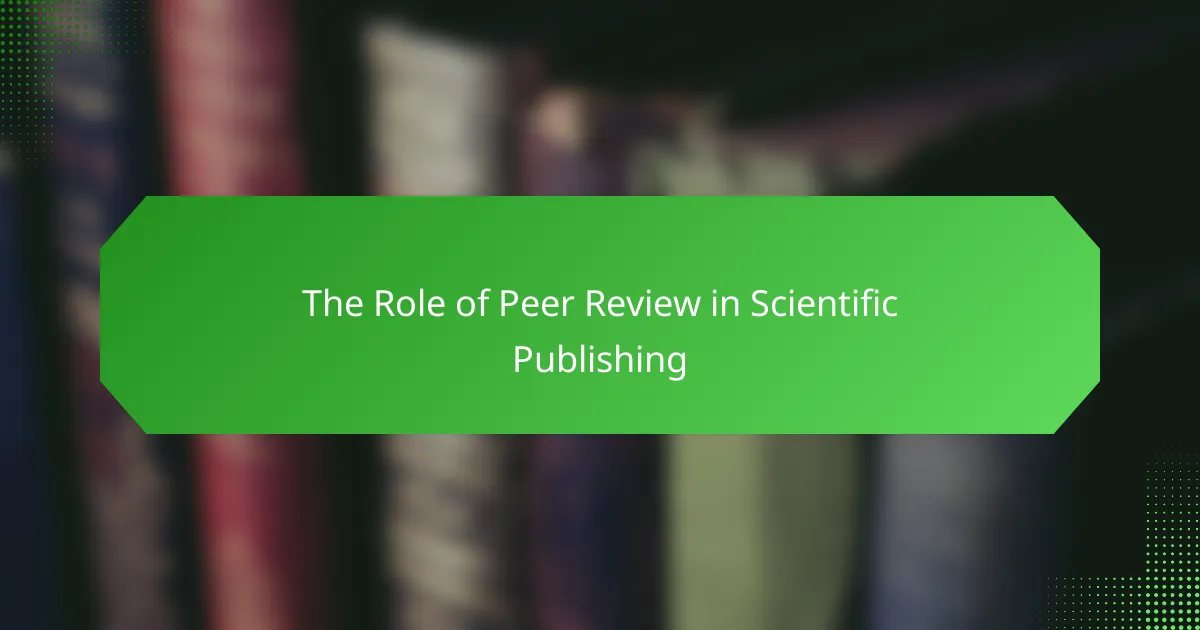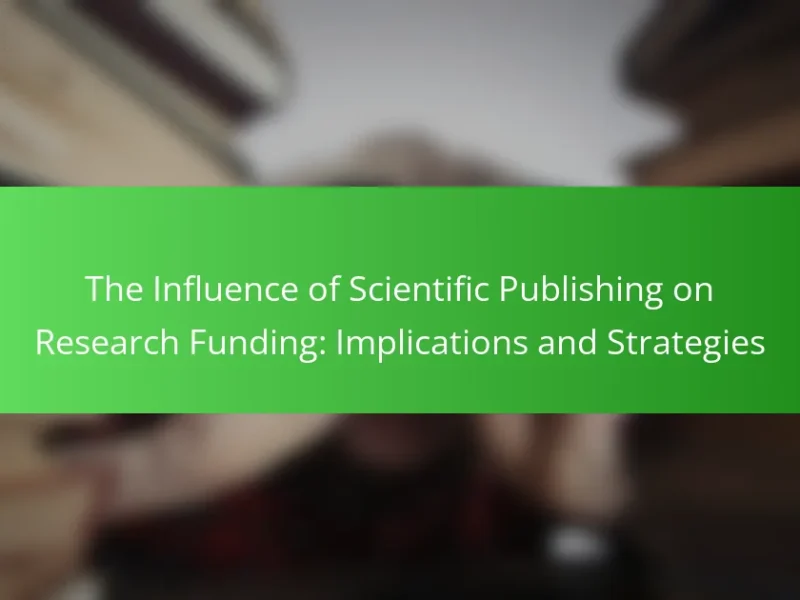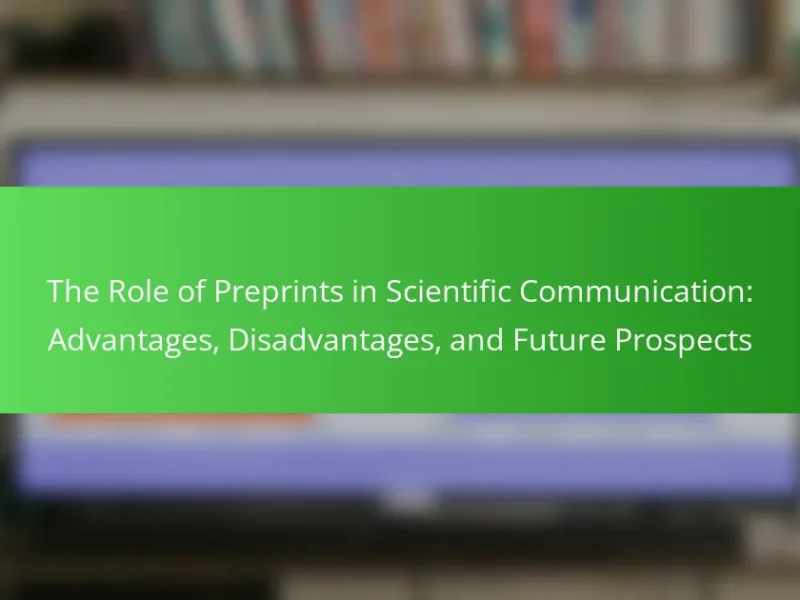Peer review is a fundamental process in scientific publishing that involves the evaluation of research by experts in the same field to ensure the quality and credibility of published work. This evaluation assesses the validity, significance, and originality of research findings, preventing the dissemination of flawed information. The article outlines the different types of peer review, including single-blind, double-blind, and open review, each with unique advantages and disadvantages affecting the integrity of the review process. Additionally, it provides guidance for authors on navigating the peer review stages, emphasizing the importance of adhering to submission guidelines, preparing clear manuscripts, and responding constructively to reviewer feedback. Understanding these elements is crucial for maintaining the integrity of scientific literature.
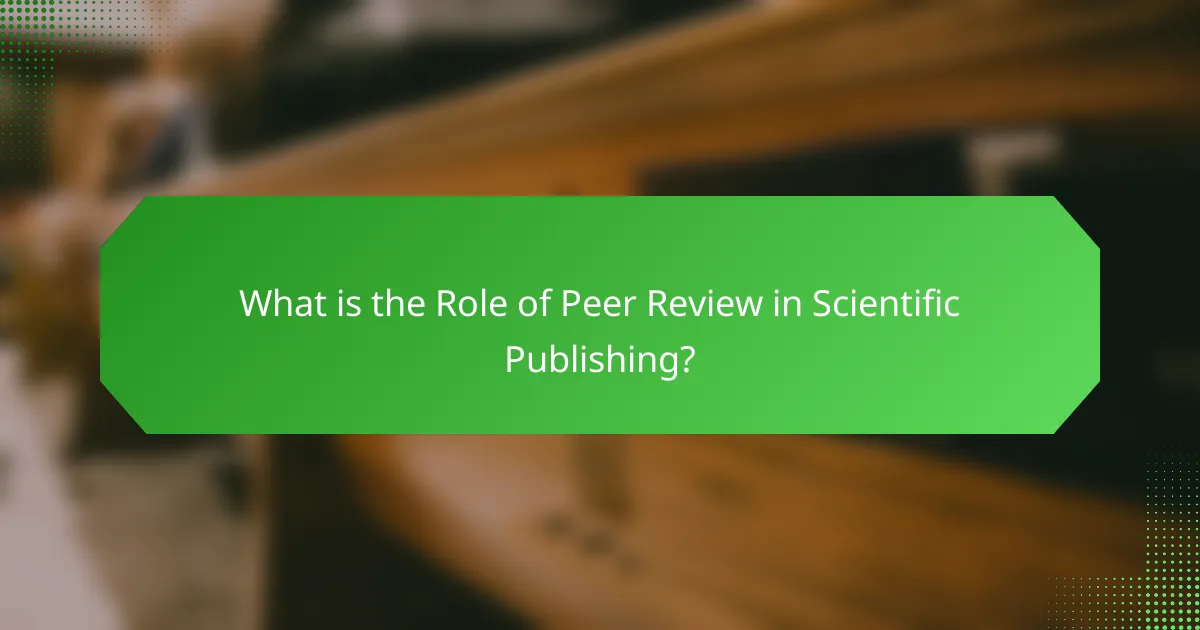
What is the Role of Peer Review in Scientific Publishing?
Peer review is a critical process in scientific publishing. It involves the evaluation of research by experts in the same field. This process ensures the quality and credibility of published research. Reviewers assess the validity, significance, and originality of the work. They provide feedback and suggest improvements. Peer review helps to prevent the dissemination of flawed or unsubstantiated findings. Studies show that peer-reviewed articles are more likely to be cited. This indicates their acceptance and trust within the scientific community. Overall, peer review upholds the integrity of scientific literature.
How does the peer review process work in scientific publishing?
The peer review process in scientific publishing involves evaluating research by experts in the field before publication. Initially, authors submit their manuscript to a journal. The journal editor then assesses the submission for relevance and quality. If deemed suitable, the editor sends the manuscript to independent reviewers. These reviewers analyze the research methodology, results, and conclusions. They provide feedback and recommend acceptance, revision, or rejection. Authors may revise their work based on reviewer comments. The editor makes the final decision on publication. This process ensures the integrity and quality of published research. Studies show that peer-reviewed articles are more likely to be cited and trusted in the scientific community.
What are the key stages of the peer review process?
The key stages of the peer review process include submission, initial assessment, reviewer selection, review, and decision.
In the submission stage, authors submit their manuscripts to a journal. The initial assessment involves the editor evaluating the manuscript for suitability. Next, the editor selects reviewers with relevant expertise. During the review stage, reviewers evaluate the manuscript’s quality and provide feedback. Finally, the editor makes a decision based on the reviewers’ comments, which can result in acceptance, revision, or rejection.
These stages ensure that published research meets scientific standards and contributes to the body of knowledge.
Who are the stakeholders involved in peer review?
The stakeholders involved in peer review include authors, reviewers, editors, and publishers. Authors submit their research for evaluation. Reviewers assess the quality and validity of the work. Editors manage the peer review process and make publication decisions. Publishers disseminate the final accepted research. Each stakeholder plays a crucial role in maintaining the integrity of scientific publishing. Their collaboration ensures that only rigorous and credible research is shared with the scientific community.
Why is peer review essential for scientific integrity?
Peer review is essential for scientific integrity because it ensures that research is evaluated by experts before publication. This process helps to identify errors, biases, and methodological flaws. It also enhances the credibility of scientific findings. According to a study published in the journal “Nature,” peer-reviewed articles are more likely to be trusted by the scientific community. Peer review fosters accountability among researchers. It encourages adherence to ethical standards in research. Overall, this process maintains the quality and reliability of scientific literature.
How does peer review contribute to the credibility of research?
Peer review enhances the credibility of research by subjecting it to evaluation by experts in the field. This process ensures that the research methodology, findings, and interpretations are rigorously assessed for accuracy and validity. Peer reviewers provide critical feedback, helping to identify any potential flaws or biases in the study. The scrutiny by knowledgeable peers increases the reliability of the published work. Studies indicate that articles that undergo peer review are more likely to be trustworthy and influential in their respective fields. Additionally, peer-reviewed research is often considered more credible by funding agencies and academic institutions, further validating its importance.
What are the potential consequences of bypassing peer review?
Bypassing peer review can lead to the dissemination of flawed research. Flawed research may contain unverified data or erroneous conclusions. This can mislead other researchers and practitioners in the field. The credibility of the scientific community may be undermined as a result. Additionally, it can result in wasted resources on ineffective or harmful practices. Public trust in scientific findings may also diminish if inaccuracies are prevalent. A lack of peer review can hinder the advancement of knowledge by allowing misinformation to spread. Overall, the integrity of scientific literature is at risk without the peer review process.
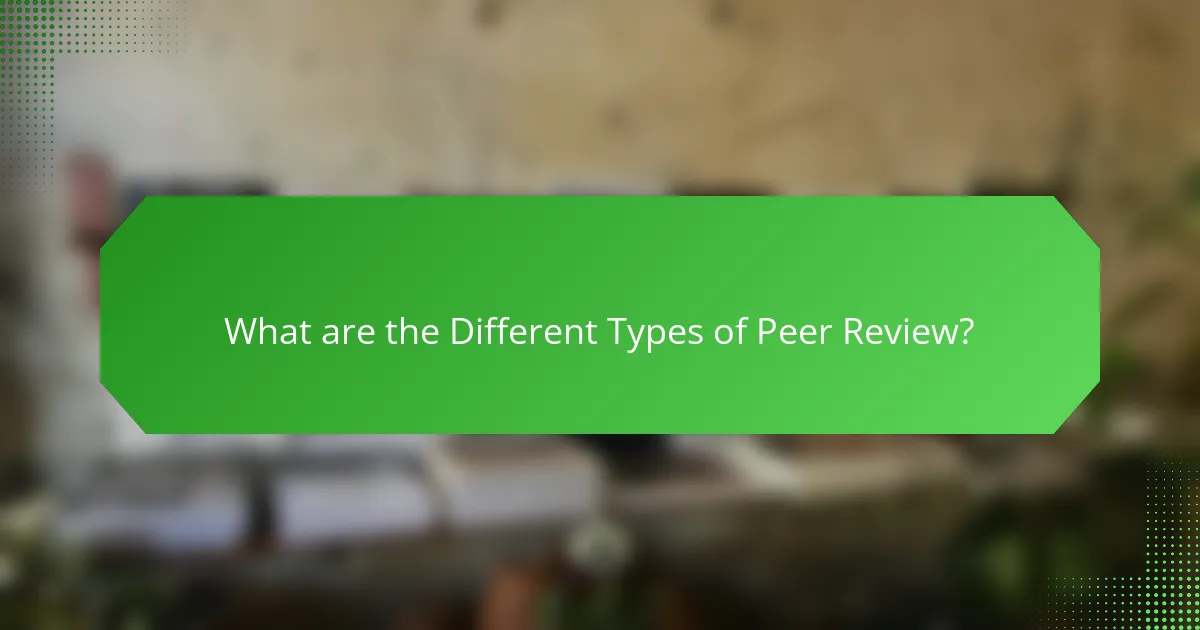
What are the different types of peer review?
The different types of peer review are single-blind, double-blind, and open review. In single-blind review, reviewers know the authors’ identities, but authors do not know the reviewers. This method can lead to bias since the reviewers may be influenced by the authors’ reputations. In double-blind review, both authors and reviewers remain anonymous to each other. This approach aims to reduce bias and promote fairness in the evaluation process. Open review allows both authors and reviewers to know each other’s identities. This transparency can enhance accountability and constructive feedback. Each type of peer review has its own advantages and disadvantages, impacting the overall quality and integrity of the review process.
How do single-blind, double-blind, and open peer review differ?
Single-blind, double-blind, and open peer review differ primarily in the visibility of reviewer identities. In single-blind review, reviewers know the authors’ identities, but authors do not know the reviewers. This can lead to biases since reviewers may be influenced by the author’s reputation. In double-blind review, both the reviewers and authors remain anonymous to each other. This method aims to reduce bias and promote fairness in the evaluation process. In open peer review, both the reviewers’ and authors’ identities are known to each other. This approach encourages transparency and accountability among reviewers. Each method has its strengths and weaknesses, affecting the overall integrity of the peer review process.
What are the advantages and disadvantages of each peer review type?
The advantages and disadvantages of each peer review type include several factors. Traditional peer review offers thorough evaluation and expert feedback. However, it can be slow and may introduce bias. In contrast, open peer review promotes transparency and accountability. This type can also lead to constructive criticism but may discourage honest feedback due to fear of backlash. Additionally, post-publication peer review allows for ongoing evaluation and correction of published work. Yet, it may lack the rigor of pre-publication reviews. Each type serves a purpose, balancing quality assurance with efficiency and transparency in the scientific publishing process.
In what contexts is each type of peer review most effective?
Each type of peer review is most effective in specific contexts. Single-blind peer review works well in fields where reviewers’ expertise is critical. This method allows reviewers to assess the quality of submissions without the authors knowing their identities. Double-blind peer review is effective in reducing bias. Both authors and reviewers remain anonymous, promoting fairness in evaluation. Open peer review enhances transparency and accountability. This context is beneficial for fostering collaboration and public trust in research findings. In fields with rapid advancements, such as technology, rapid peer review is crucial. It ensures timely dissemination of knowledge while maintaining quality. Each type adapts to the needs of different disciplines and research environments.
What challenges does the peer review process face?
The peer review process faces several significant challenges. One major challenge is the increasing volume of submissions, which can overwhelm reviewers. This often leads to longer review times and can delay the publication of important research. Another challenge is the potential for bias among reviewers, which can affect the objectivity of the evaluation. Additionally, there is a shortage of qualified reviewers in many fields, making it difficult to find appropriate experts for each submission. Conflicts of interest can also compromise the integrity of the review process. Finally, the rise of predatory journals has introduced further complications, as these journals may not adhere to proper peer review standards.
How do biases and conflicts of interest impact peer review?
Biases and conflicts of interest significantly undermine the integrity of peer review. Biases may lead reviewers to favor studies that align with their beliefs or affiliations. This can result in unfair evaluations and skewed publication outcomes. Conflicts of interest arise when reviewers have financial or personal stakes in the research being evaluated. Such conflicts can compromise objectivity, leading to biased recommendations. Research indicates that 30% of reviewers do not disclose conflicts of interest, further exacerbating the issue. The presence of biases and conflicts can ultimately diminish the credibility of published research. This impacts the advancement of science and trust in scientific literature.
What are the implications of peer review delays on scientific progress?
Peer review delays significantly hinder scientific progress. These delays can extend the time it takes for research findings to be published and disseminated. Consequently, important advancements may remain unrecognized for longer periods. This can slow down the overall pace of innovation in various fields. Researchers may also face challenges in securing funding as they await publication. Additionally, delayed peer review can lead to redundancy, where multiple teams work on similar problems without knowledge of each other’s efforts. The cumulative effect is a potential stagnation in scientific development. Studies indicate that timely publication is crucial for maintaining the relevance of research in fast-evolving disciplines.
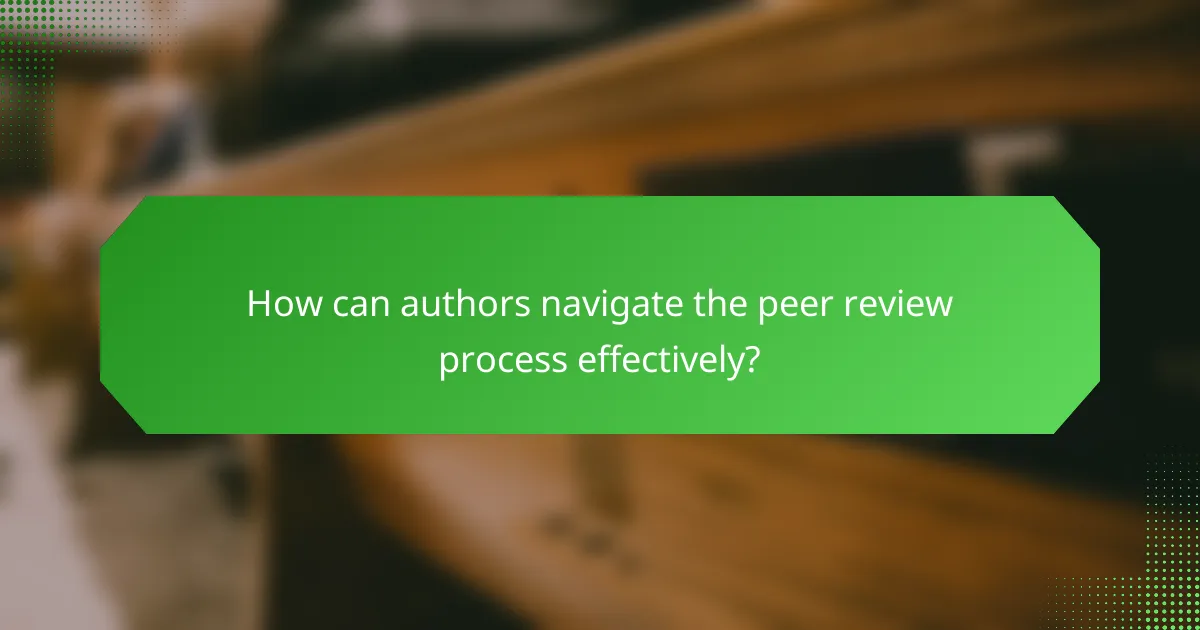
How can authors navigate the peer review process effectively?
Authors can navigate the peer review process effectively by understanding its stages and requirements. They should carefully read the submission guidelines of the journal. Adhering to formatting and style requirements increases the chance of acceptance. Authors must prepare a clear and concise manuscript. Clarity improves reviewer comprehension and feedback quality. Engaging with co-authors for revisions enhances the manuscript’s quality. Authors should be open to constructive criticism during the review process. Responding thoughtfully to reviewer comments can improve the manuscript. Timely revisions demonstrate professionalism and respect for the review process.
What best practices should authors follow when submitting for peer review?
Authors should ensure their manuscript is formatted according to the journal’s guidelines. This includes adhering to specific styles for citations and references. Authors must also provide a clear and concise abstract summarizing the research. Additionally, they should include a cover letter that outlines the significance of their work. Transparency about potential conflicts of interest is crucial. Authors should also ensure that all co-authors have approved the submission. Properly addressing reviewer comments in a revision is essential for resubmission. Lastly, authors should maintain a positive and professional tone throughout the submission process.
How can authors respond to reviewer comments constructively?
Authors can respond to reviewer comments constructively by acknowledging feedback and addressing concerns directly. They should carefully read each comment and categorize them into major and minor issues. For major issues, authors must provide detailed explanations or revisions to demonstrate understanding. For minor comments, authors can indicate whether changes were made or explain why they were not necessary. Authors should maintain a professional tone and express gratitude for the feedback. This approach fosters a collaborative atmosphere and shows respect for the review process. Constructive responses can lead to improved manuscript quality and a higher likelihood of acceptance.
What strategies can authors use to improve their chances of acceptance?
Authors can improve their chances of acceptance by adhering to journal guidelines. Each journal has specific submission requirements that must be followed. Authors should ensure their manuscript aligns with the journal’s scope. This includes formatting, length, and citation style.
Additionally, authors should conduct thorough literature reviews. This demonstrates awareness of existing research and identifies gaps their work addresses. Engaging with peer feedback before submission is also beneficial. Feedback can identify weaknesses and improve the manuscript’s quality.
Authors should also write clearly and concisely. Clarity enhances understanding and makes a stronger impact on reviewers. Furthermore, including robust data and methodology strengthens the manuscript’s credibility.
Finally, authors should consider the timing of their submission. Aligning with current trends or emerging topics can increase relevance. These strategies collectively enhance the likelihood of acceptance in scientific publishing.
What resources are available for understanding peer review?
Resources available for understanding peer review include academic journals, online courses, and educational websites. Academic journals often provide articles discussing the peer review process. These articles can be found in publications like “Nature” and “Science.” Online courses on platforms such as Coursera and edX offer structured learning about peer review. Educational websites like the American Psychological Association and Elsevier provide guides and FAQs on peer review. Additionally, books such as “Peer Review and Manuscript Management in Scientific Journals” by S. J. H. M. van Dongen offer in-depth insights. These resources collectively enhance comprehension of the peer review process in scientific publishing.
Where can authors find guidelines and support for the peer review process?
Authors can find guidelines and support for the peer review process on various academic publisher websites. Many publishers, such as Elsevier and Springer, provide detailed instructions for authors regarding submission and peer review. Additionally, the Committee on Publication Ethics (COPE) offers resources and guidelines on ethical peer review practices. These resources are designed to help authors navigate the peer review process effectively. Furthermore, academic institutions often have writing centers that provide support and guidance for authors during the peer review process.
How can researchers stay informed about changes in peer review practices?
Researchers can stay informed about changes in peer review practices by subscribing to relevant journals and newsletters. Many academic journals provide updates on their peer review processes. Researchers can also follow professional organizations that focus on publishing standards. These organizations often release guidelines and reports on peer review trends. Attending conferences related to academic publishing can provide insights into current practices. Engaging in online forums and social media groups dedicated to research can facilitate discussions about peer review. Additionally, reviewing articles that discuss peer review methodologies can enhance understanding of evolving practices. Keeping an eye on studies and surveys about peer review can also be beneficial.
The main entity of this article is peer review in scientific publishing. Peer review is a fundamental process that evaluates research for quality and credibility, involving authors, reviewers, editors, and publishers. The article outlines the stages of the peer review process, the importance of peer review for maintaining scientific integrity, and the different types of peer review, including their advantages and disadvantages. It also discusses challenges faced by the peer review process, strategies for authors to navigate it effectively, and resources available for understanding peer review practices. Overall, the article emphasizes the critical role peer review plays in ensuring the reliability and trustworthiness of scientific literature.
